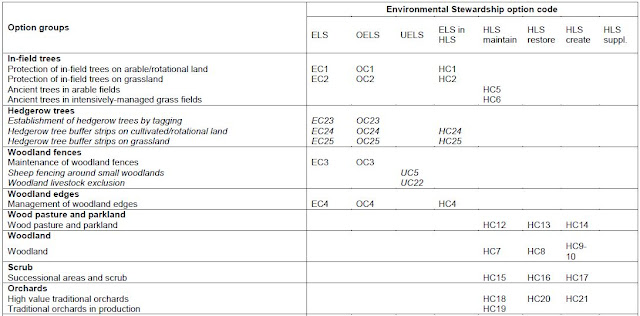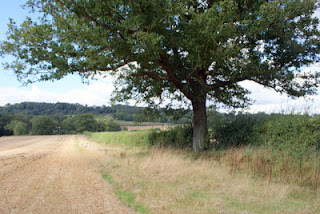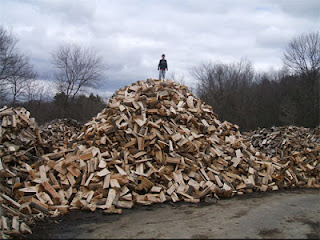Natural England has released a new report entitled "Ecosystem services from Environmental Stewardship that benefit agricultural production". Given that trees and woodland form a key part of the agricultural landscape we've taken a quick look at the report to see what it says about them.
We've borrowed heavily from the report for this article - for the complete document click
here.
Overview
This report reviews the
ecosystem services provided by
Environmental Stewardship (ES), the main agri-environmental scheme in England. It is concerned with those that are of benefit to agricultural (especially crop) production.
- Ecosystem services can be described as the full range of benefits that people and societies obtain from biological systems, including provisioning, regulating, cultural and supporting services.
- Key ecosystem services considered include soil formation, nutrient cycling, carbon sequestration, water regulation and purification, genetic resources, pest regulation and pollination.
Role of Environmental Stewardship in providing ecosystem services
Environmental Stewardship has the potential to enhance a range of ecosystem services of benefit to agricultural production, though relatively few options have been designed specifically with this purpose in mind.
 |
| Farm woodland in the Sevenoaks area |
ES options generally involve either taking land out of production or modifying the production system to enhance environmental benefits, thus reducing production. Indeed, payments to farmers for their participation in the scheme are calculated on the basis of 'profit foregone' as a result of taking up the options concerned.
Although ES options may enhance overall primary production in some cases (e.g. of woodland or hedgerows), they do not generally increase agricultural production. However, they may help to reduce costs of production by reducing use of inputs such as diesel or fertiliser on less productive areas of land.
 |
| ES options involving trees, hedges, woodland, scrub and orchards |
What do the results show?
The following sections summarise the role played by trees and woodland in providing ecosystem services in the context of ES and agriculture.
In-field trees
 |
| Hedgerow planting on farmland near Ightham |
- In-field trees can substantially contribute to carbon sequestration and soil formation by providing organic matter for decomposition.
- The overall impact is likely to be small, although there should be some benefit overall at the national scale.
- Ancient trees will not sequester carbon to the same extent as younger trees. However, this option will prevent the destruction of older trees and so limit the release of stored CO2 into the atmosphere.
- For ancient trees on cultivated land, the 15m radius grass area around the base of the tree will provide some of the benefits of an in-field buffer.
Woodland edges
- Woodland edges will provide a year-round cover of vegetation that can sequester carbon, contribute to soil organic matter accumulation and reduce water erosion.
- Any reductions in wind erosion due to the woodland edge option are likely to be negligible compared to the protection afforded by the woodland itself.
Wood pasture and parkland
- Wood pasture and parkland puts relatively little pressure on the land and so it is sustainable, assuming that it is managed appropriately.
- There is a year-round cover of vegetation and the trees can sequester and store relatively large amounts of carbon.
- Whilst there is no direct evidence from wood pastures, their potential for sequestration and/or contributions to soil fertility can be inferred from data relating to woodland.
- Poulton et al (2003) quantified C and N content of soil in land that was arable for centuries until the late 1800‘s and has since reverted to woodland. The acidic site (mainly oak) gained 2.00 t C/ha/yr over the 118-year period (0.38 t in litter and soil to a depth of 69 cm, plus an estimated 1.62 t in trees and their roots); there were also gains of nitrogen.
- Hughes-Clarke & Mason (1992) examined 35 field corner plantations adjacent to arable fields and noted a significant increase in total N and total C under the plantations compared to the arable land.
 |
| High forest near Sevenoaks |
Trees can increase the rate of infiltration (Broadmead & Nisbet, 2004) which will assist in water regulation. Work in the Pontbren region in Wales has demonstrated that areas of sheep pasture planted with trees can increase the infiltration rate by up to 60 times after 6 years, although significant increases were observed after only two years (Carroll et al., 2004).
Creation of wood pasture (HLS option HC14) will have the greatest benefit, but restoration and maintenance options (HC12 and 13) will also have benefits in terms of maintaining the ecosystem services provided by these habitats.
Woodland
- The role of woodlands in regulating water quantity will be the primary benefit to agricultural production, although the beneficiary may not be the farm implementing the option, but a farm downstream.
- Managed woodland can be used for the production of wood as well as livestock.
- Carbon sequestration in conifer and broadleaf woodland is estimated to be in the order of 11 t/ha/year.
Scrub
- The presence of a vegetative cover can assist in preventing soil erosion and creating a reservoir for beneficial soil biota.
- Where it is used as a buffer, there will be some benefit to agricultural production due to reduced losses of soil and associated soil organic matter, and a reduced potential for runoff.
Orchards
 |
| No Mans Orchard near Canterbury |
- These systems, like woodlands and wood pastures, put little pressure on soil resources and can contribute to soil formation and water regulation.
- ES option HC21, creation of traditional orchards, will have major ecosystem services benefits if created from more intensively managed land, whilst options HC18, HC18 and HC20, will benefit agricultural production as the orchard will be maintained or restored so that fruit production continues, whilst also providing other ecosystem services.




